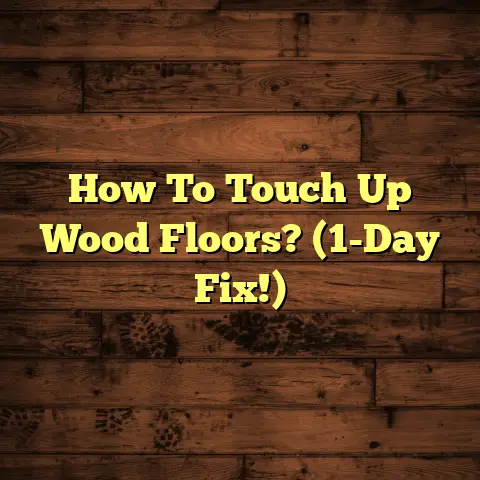Can Mold Grow On Hardwood? (Act Fast!)
Can mold really grow on hardwood? The short answer is YES. And if it does, you need to act fast.
In this article, we’re diving deep into the world of hardwood and mold. We’ll debunk myths, explore the science, and give you a practical guide to protect your beautiful floors. Let’s get started!
Section 1: Understanding Hardwood Flooring
Hardwood flooring – it’s classic, elegant, and adds real value to your home. From oak and maple to cherry and walnut, there’s a hardwood for every style and budget. These floors are known for their durability and timeless appeal.
But let’s be real, hardwood isn’t invincible. While it can withstand a lot, there are some common misconceptions that can lead to trouble.
Debunking Hardwood Myths
Let’s tackle some myths I often hear:
-
Myth 1: Hardwood is Completely Waterproof.
Nope! Hardwood is water-resistant, not waterproof. Think of it like a good raincoat – it can handle some rain, but it’s not designed for a swim. Excessive moisture can soak into the wood, causing warping, swelling, and, you guessed it, mold growth. * Myth 2: Mold Cannot Grow on Hardwood at All.
This is a big one. Mold absolutely can grow on hardwood. Mold needs organic material to feed on, and wood is definitely organic. Add moisture and warmth, and you’ve created the perfect breeding ground. * Myth 3: All Hardwood Types Are Equally Resistant to Mold.
Not true. Some hardwoods are denser and more resistant to moisture than others. For example, Ipe and Teak are naturally more resistant to moisture and decay due to their oil content. However, even these resilient species aren’t immune to mold if conditions are right.
According to the USDA Forest Products Laboratory, “wood species with high natural decay resistance are still susceptible to mold growth if moisture content is high enough” (Source: USDA FPL Research Note FPL-RN-0268).
Section 2: The Science Behind Mold Growth
Okay, let’s get a little science-y. What exactly is mold?
Mold is a type of fungus that thrives in damp environments. It reproduces through tiny spores that float in the air. When these spores land on a surface with enough moisture, warmth, and a food source (like wood), they start to grow.
Types of Mold on Hardwood
There are countless types of mold, but some common ones I see on hardwood include:
- Cladosporium: Often appears as black or green spots.
- Aspergillus: Can be various colors, including green, yellow, or black.
- Penicillium: Usually blue-green in color.
These molds flourish in conditions that provide:
- Moisture: From leaks, spills, high humidity, or condensation.
- Temperature: Mold grows best in warm, humid environments.
- Organic Material: Wood, dust, dirt, and even some adhesives.
According to the EPA, mold can start growing within 24-48 hours in the right conditions. (Source: EPA “A Brief Guide to Mold, Moisture, and Your Home”).
Mold Prevalence in Homes
Mold is more common than you might think. A study by the American Society of Home Inspectors (ASHI) found that mold is present in a significant percentage of homes. While exact numbers vary, it’s safe to say that mold is a widespread issue, especially in areas with high humidity or a history of water damage.
Section 3: Factors Contributing to Mold Growth on Hardwood
Alright, now let’s get specific. What everyday situations can lead to mold growth on your hardwood floors?
-
Excess Moisture:
This is the biggest culprit. Leaks from plumbing, leaky roofs, or even overflowing appliances can saturate your hardwood. Spills that aren’t cleaned up promptly can also seep into the wood. * Poor Ventilation:
Bathrooms, kitchens, and basements are prime candidates for mold growth due to poor ventilation. If moisture can’t escape, it lingers, creating a humid environment that mold loves. * Inadequate Cleaning and Maintenance:
Think of dust and dirt as a buffet for mold. Regularly sweeping, vacuuming, and cleaning your hardwood can remove these food sources and prevent mold from taking hold. * Organic Materials:
Besides the wood itself, organic materials like dust, pet dander, and even certain types of adhesives used in flooring installation can provide nutrients for mold growth.
These factors often work together. For example, a small leak under your sink combined with poor ventilation can create the perfect storm for mold.
Section 4: Signs of Mold Growth on Hardwood
Knowing what to look for is half the battle. Here are some telltale signs that mold might be lurking on your hardwood:
-
Discoloration:
Keep an eye out for dark spots, stains, or any unusual discoloration on your flooring. Mold can appear as black, green, brown, or even white patches. * Musty Odors:
This is a classic sign of mold. If you notice a persistent musty or earthy smell, especially in damp areas, it’s time to investigate. * Peeling or Warping:
Mold can weaken the wood fibers, causing the flooring to peel, warp, or even buckle. This is a sign of more advanced mold damage.
Mold vs. Other Stains
It’s important to differentiate mold from other types of staining. Water stains, for example, might look similar to mold, but they usually lack the fuzzy texture and distinct odor. However, if you’re unsure, it’s always best to err on the side of caution and treat it as potential mold.
Section 5: Health Risks Associated with Mold on Hardwood
Mold isn’t just bad for your floors; it can also be bad for your health. Exposure to mold can trigger a range of health problems, including:
-
Respiratory Issues:
Mold spores can irritate your lungs and airways, leading to coughing, wheezing, shortness of breath, and other respiratory symptoms. * Allergies:
Mold is a common allergen. Exposure can cause sneezing, runny nose, itchy eyes, and skin rashes. * Other Health Concerns:
In some cases, mold exposure can lead to more serious health problems, such as asthma attacks, fungal infections, and even neurological issues.
Vulnerable Populations
Certain groups are more susceptible to the health effects of mold, including:
- Children: Their developing immune systems are more vulnerable.
- The Elderly: They may have weakened immune systems and pre-existing health conditions.
- Individuals with Pre-existing Health Conditions: People with asthma, allergies, or compromised immune systems are at higher risk.
Section 6: Detecting Mold on Hardwood
Time to put on your detective hat! Here’s how to inspect your hardwood floors for mold:
-
Visual Inspection:
Start by carefully examining your floors for any signs of discoloration, stains, or fuzzy growth. Pay close attention to areas near plumbing, windows, and exterior doors. * Smell Test:
Sniff around! If you detect a musty or earthy odor, especially in damp areas, it’s a red flag. * Professional Mold Testing:
If you suspect mold but aren’t sure, consider hiring a professional mold inspector. They can take samples and send them to a lab for analysis to identify the type and extent of the mold.
Early Detection is Key
The sooner you detect mold, the easier it is to deal with. Small mold problems can often be handled with DIY methods, but larger infestations require professional remediation.
Section 7: Immediate Actions to Take if Mold is Detected
Okay, you’ve found mold. Don’t panic! Here’s what to do:
-
First Steps:
- Isolate the Area: Seal off the affected area with plastic sheeting and tape to prevent mold spores from spreading.
- Improve Ventilation: Open windows and use fans to dry out the area.
-
Safety Precautions:
-
Wear Protective Gear: Always wear a mask (N-95 or higher), gloves, and eye protection when dealing with mold.
- Avoid Inhaling Spores: Try to minimize disturbance of the mold to prevent spores from becoming airborne.
-
Initial Cleaning Methods:
-
Surface Mold Removal: For small areas of surface mold, you can try cleaning with a mixture of mild detergent and water.
- Use a Scrub Brush: Gently scrub the affected area to remove the mold.
- Dry Thoroughly: Make sure to dry the area completely after cleaning.
Important: If the mold covers a large area (more than 10 square feet) or if you suspect it has spread beyond the surface, it’s time to call in the pros.
Section 8: Professional Mold Remediation
When DIY isn’t enough, it’s time to call in the experts. Here’s when professional mold remediation is necessary:
- Extensive Mold Growth: If the mold covers a large area or has penetrated deep into the wood.
- Health Concerns: If you or your family members are experiencing health problems related to mold exposure.
- Recurring Mold Problems: If you’ve tried to remove the mold yourself, but it keeps coming back.
What Does Professional Remediation Involve?
A professional mold remediation process typically includes:
- Assessment: A thorough inspection to determine the extent of the mold growth and identify the source of moisture.
- Containment: Sealing off the affected area to prevent mold spores from spreading.
- Removal: Removing the mold-infested materials, such as drywall or carpeting.
- Cleaning and Disinfection: Cleaning and disinfecting the affected area to kill any remaining mold spores.
- Prevention: Identifying and addressing the source of moisture to prevent future mold growth.
Section 9: Preventing Mold Growth on Hardwood Flooring
Prevention is always better than cure. Here are some tips to keep your hardwood floors mold-free:
-
Maintain Proper Humidity Levels:
- Use a Dehumidifier: In humid climates, use a dehumidifier to keep indoor humidity levels below 50%.
- Air Conditioning: Use air conditioning to control temperature and humidity.
-
Ensure Adequate Ventilation:
-
Open Windows: Open windows regularly to ventilate your home.
- Use Exhaust Fans: Use exhaust fans in bathrooms and kitchens to remove moisture.
-
Regular Cleaning and Maintenance:
-
Sweep and Vacuum Regularly: Sweep and vacuum your hardwood floors regularly to remove dust, dirt, and debris.
- Clean Spills Immediately: Clean up spills immediately to prevent moisture from soaking into the wood.
- Use Appropriate Cleaning Products: Use cleaning products specifically designed for hardwood floors.
-
Routine Inspections:
-
Check for Leaks: Regularly check for leaks around plumbing, windows, and exterior doors.
- Inspect Under Appliances: Inspect under appliances like washing machines and dishwashers for signs of leaks.
Conclusion
So, can mold grow on hardwood? Absolutely. But with knowledge and vigilance, you can protect your beautiful floors and your family’s health.
Remember, while hardwood is durable, it’s not invincible. Moisture is the enemy, and prevention is key.
Don’t wait until you see the telltale signs of mold. Take action now to maintain a healthy and mold-free home. Your floors (and your lungs) will thank you!





